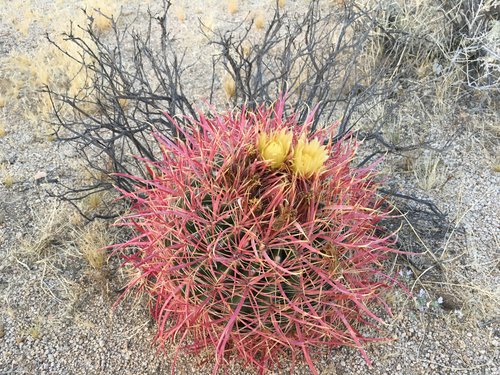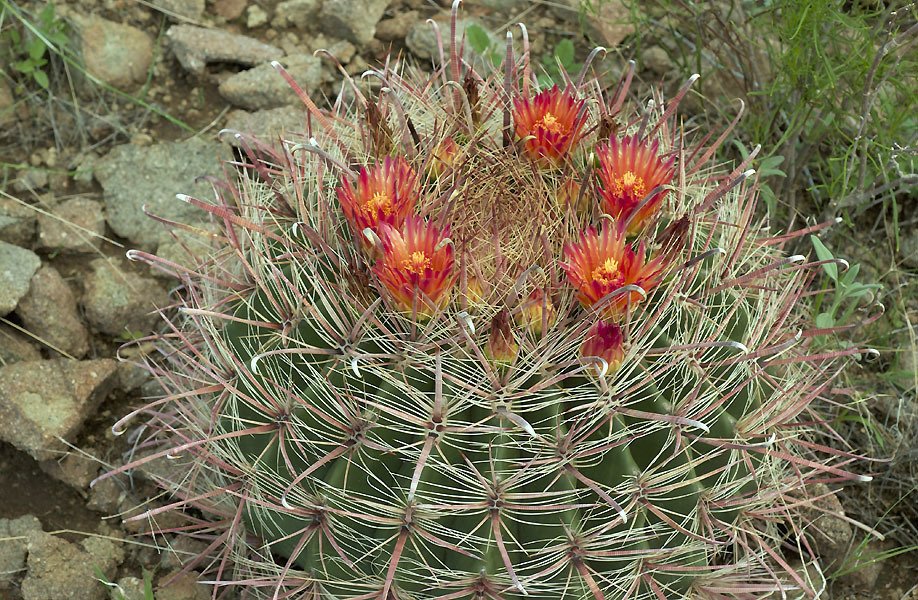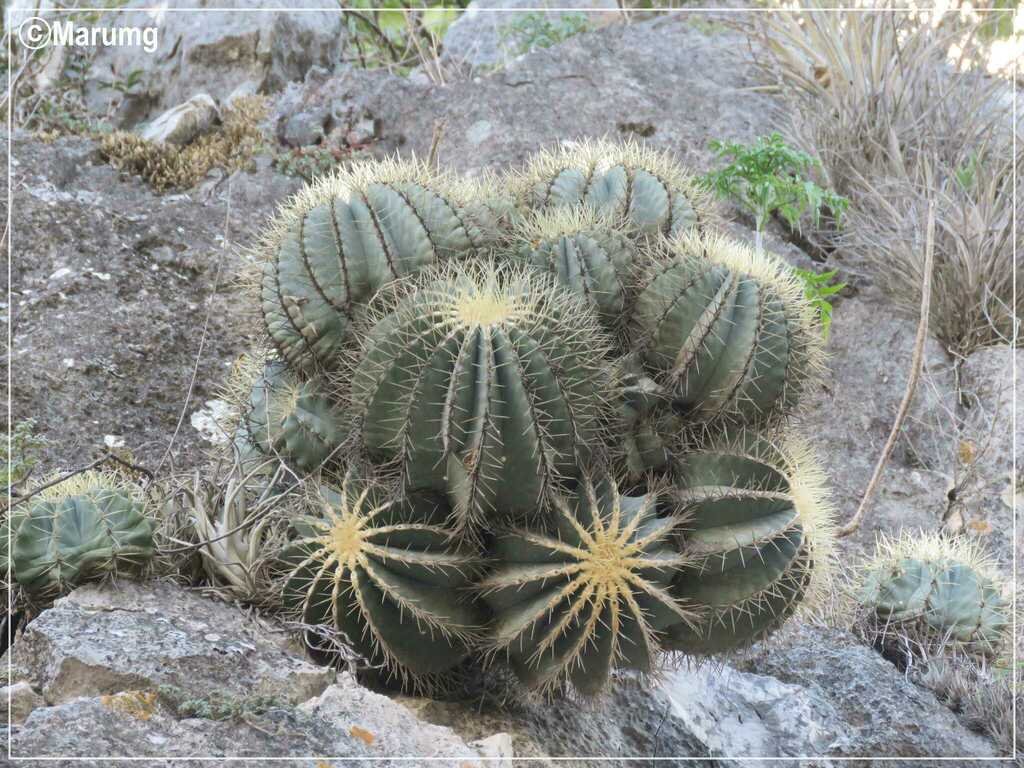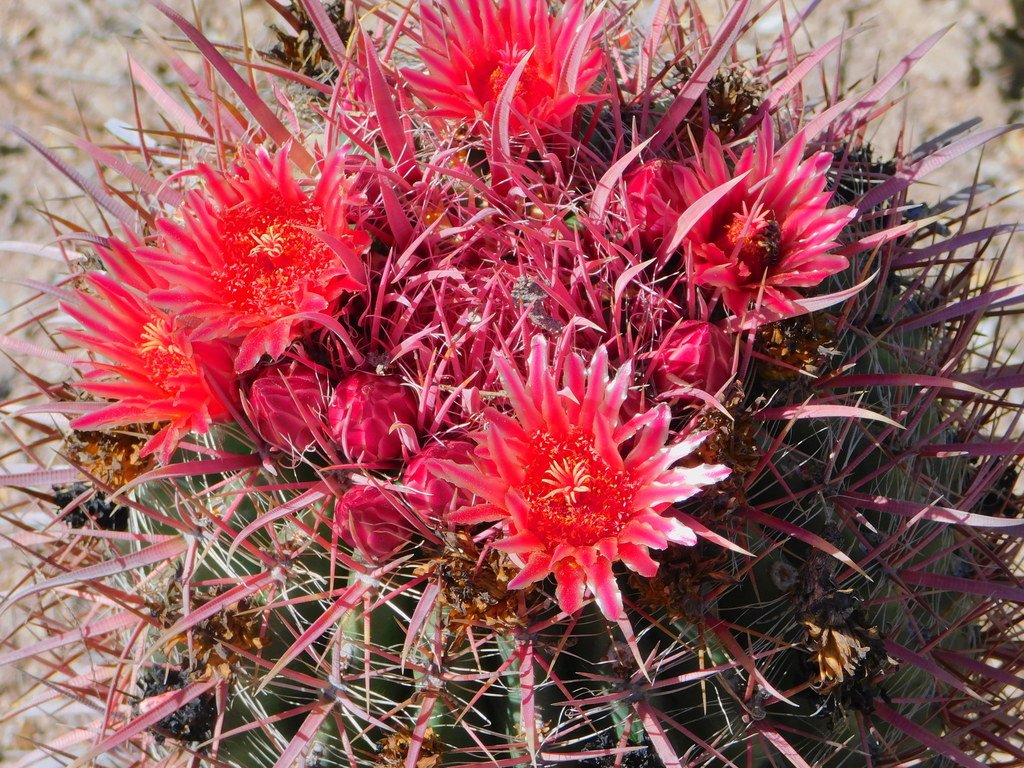Ferocactus
and Other Barrel-Type Cacti
Family: Cactaceae
Barrel cacti range from smaller to surprisingly tall plants. They usually have beautiful if brief flowering periods, and often have fruits that follow the flowers. There are 30 species of the genus Ferocactus (the genus that most barrel-type cacti belong to) southwestern United States and northwestern Mexico. But there are a few other barrel types in other genera. Most take very low water, and are somewhat cold hardy.
Photo of a younger Fishhook Barrel Cactus (Ferocactus wislizeni) by Ad Konings, iNaturalist
Make sure when you plant barrel cacti that you orient them in the same way they were growing in the nursery. Good nurseries will have the south side of the cactus marked for you, unless they were grown in shadier conditions. Barrel cacti can grow in shadier conditions than their reputation betrays. Afternoon shade in summer isn’t a bad idea for keeping them looking good. Growing cacti under filtered sun of a shade cloth is ideal if you have the ability—use about 50% shade.
Water monthly in summer (in the ground), weekly in containers. Water seldom in winter unless there has been no rain. Cold hardiness varies (listed under each species below).
Barrel cacti are important for certain species of native bees. Humans eat the fruits of some barrels though many don’t have much palatable about them (a few do). Some fruits that aren’t quite palatable raw can be cooked into preserves or chutney.
The Alamos Barrel Cactus (Ferocactus alamosanus) gets up to 3' tall and a foot wide. Plants can take a light, brief frost but should be protected in hard cold snaps. Photo by Diego Abel Rivera, iNaturalist

California Barrel Cactus (Ferocactus cylindraceus) is a variable species that can grow up to 9' tall, though plants this tall are becoming more rare. The species is native to the eastern Mojave Desert and western Sonoran Desert Ecoregions in: Southern California, Nevada, Arizona, and Utah in the Southwestern United States; and Baja California, and Sonora state in Northwestern Mexico. The spines are straight and red when new and become curved and gray as they age. There are 3 subspecies. Hardy to 10-15°F. Photo by Tina Treude, iNaturalist
The Yellow-Spined Barrel Cactus (Ferocactus chrysacanthus) is an endangered species of cactus endemic to the islands of Cedros and West San Benito off the Pacific coast of Baja California, Mexico. The spines can be white, yellow, red, or occasionally gray. Hardy to about 20°F. Photo by Tom Wainwright, iNaturalist

Emory's Barrel Cactus (Ferocactus emoryi) is a barrel that can reach 6-8' tall, but often much smaller. They usually have red flowers but sometimes yellow-flowering. This species is found in nature in Mexico (Sonora, Sinaloa and Baja California Sur) and in the United States (Arizona). Hardy to 20°F. Photo by Ad Konings, iNaturalist
The long-spined Emory Barrel Cactus (Ferocactus emoryi subsp. rectispinus) has very long central spines. Photo by Glenn Ehrenberg, iNaturalist
Ford's Barrel Cactus (Ferocactus fordii) grows 1-2' tall and wide. It is endemic to the Baja California Peninsula. Pink to almost purple flowers. Hardy to the high 20s°F. Photo by Vince Scheidt, iNaturalist
A multiheaded specimen of the Blue Barrel (Ferocactus glaucescens). is either solitary or sometimes clustering barrel with blueish flesh and yellow spines. Native to the limestone hills and dry forest of Hidalgo, Guanajuato, Querétaro, and San Luis Potosí states of Mexico. Yellow flowers. Hardy into the low 20s°F. Photo by María Eugenia Mendiola González, iNaturalist
The Fire Barrel Cactus (Ferocactus gracilis) can reach 5' tall. Red flowers and red spines. Hardy to 20°F. Photo by Jose Luis Leon de la Luz, iNaturalist
The pink-flowering Ferocactus haematacanthus grows up to 4' tall. Hardy to about 15°F. Photo by La Yunta, iNaturalist
Acitrón barrel cactus (Ferocactus histrix) gets about 3' tall and has yellow spines that age to gray. Commonly found throughout all the Central Mexican matorral. It produces an edible fruit appreciated for its sour taste. Hardy to 25°F. Photo by Monitoreo Mesita Conanp, iNaturalist
The Devil's Tongue Cactus (Ferocactus latispinus) is unusual for many reasons--winter flowering (most barrels flower in summer), purple flowers, and flattened central spines. Hardy into the low 20s°F. Photo by Annie Spencer, iNaturalist
Mexican Lime Cactus (Ferocactus pilosus) can form large clumps or be solitary. They can grow as high as 10' tall! Yellow or red flowers. Hardy to 15°F. Photo. by Zona Sujeta a Conservación Ecológica Sierra de Zapalinamé, iNaturalist
Extremely unusual for a Ferocactus, the Clumping Barrel (Ferocactus robustus) clusters to form massive colonies that can reach 15' wide or more. Yellow flowers. Hardy to 25°F. Photo by Gerardo Tapia Hervert Calderón, iNaturalist
Fishhook Barrel Cactus (Ferocactus wislizeni) is probably the most common native barrel cactus in our region. They usually grow 3-6' tall but specimens up to 10' are known. Yellow to red-orange flowers. Hardy to 15°F. Photo by Ken Kneidel, iNaturalist













